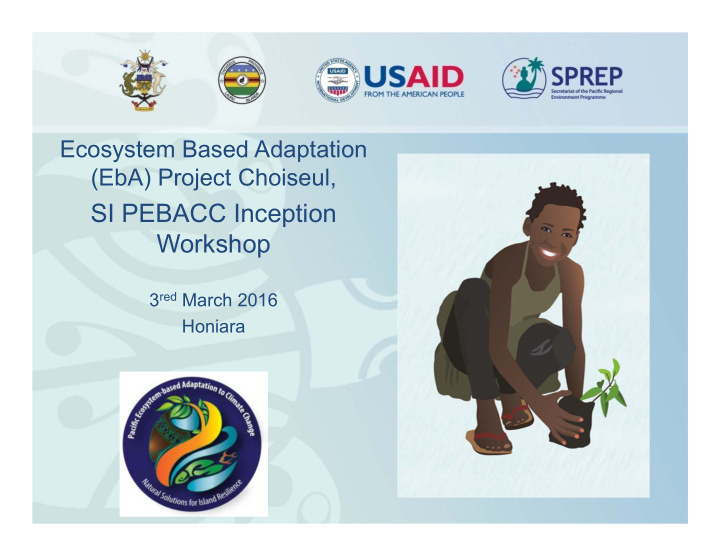



Ecosystem Based Adaptation (EbA) Project Choiseul, SI PEBACC Inception Workshop 3 red March 2016 Honiara
SPREP-USAID Ecosystem –based Adaptation Project. • USAID – Funded up September 2012 to September 2015…..extended to December 2015 • Focuses on four sites; Choiseul bay, Sasamuga, Mt Maetambe, South Choiseul - Wagina • SPREP and LLCTC sign MOU in April 2015 for their partnership in implementing their activities. • Implemented by SPREP in collaboration with the Choiseul Integrated Climate Change Programme (CHICCHAP) • Pacific Ecosystem-based Adaptation to Climate Change (PEBACC) focuses on South Choiseul and Honiara .
• EbA definition; Ecosystem ‐ based approaches to adaptation may include sustainable management as well as conservation and restoration of ecosystems, as part of an overall adaptation strategy that takes into account the multiple social, economic and cultural co ‐ benefits for governments and local communities. (CBD 2nd Ad Hoc Technical Expert Group (AHTEG) on Biodiversity and Climate Change
Key components of the Choiseul SPREP-USAID EbA Project 2.1Coordination of Project Delivery 2.2 Climate Change Vulnerability Assessment 2.3 EbA Planning and Mainstreaming 2.4 EbA Implementation 2.5 Training and Capacity Building on EbA 2.6 Communication and Knowledge Management
1. Climate change vulnerability assessment. Objectives; 1. To assess (quantitatively and qualitatively) provincial vulnerability, given the impacts imposed by climate change and non-climate change factors on sectors and systems . 2. to assess and identify measures to reduce vulnerabilities and improve the AC of Choiseul communities; 3. to identify the four or five most suitable communities for demonstration of RCR and EbA adaptation approaches.
The assessment is undertaken in three components ; y p p g Component 1: Desktop & Scientific Community Profiles Studies Component 3: V&A V&A Component 2: Field-based Studies Meta-Analysis Report 2a: Community-based Studies 2b: V&A team Studies
Communities visited in Choiseul • 28 Villages selected – 2 from each of the 14 wards. • A village selection process involved 10 people making recommendations. • Community specific results and suggested adaptation responses were included in individual community profiles.
Key vulnerabilities identified and categorised (V& A report) 1. Land and forest vulnerability 2. Marine vulnerability 3. Coastal vulnerability 4. Community vulnerability
Vulnerability assessment summary V&A results
Climate change vulnerability assessment recommended six major adaptation options; 1. Minimizing damage to village infrastructure 2. Management and protection of inter tidal and coastal areas 3. Increasing food security and livelihoods 4. Protection of water resources 5. Marine and fisheries management 6. Increase disaster preparedness
All adaptation activities focus on Ridge to Reef with the community as the central point.
2. SPREP-USAUD -Scoping to identify EbA demonstration sites and EbA options 1. Mt Maetambe and Kolombangara river catchment 2. South Choiseul – Robroy and Wagina 3. Sasamuga – Pirini Watershed 4. Choiseul Bay – Focus on Taro Island
1. Mt Maetambe and Kolombangara river catchment ‐ BIORAP with ESSI, LLCTC and other agencies Mammals – 3 Bats & Flying foxes ‐ 10 Reptiles – 25 Frogs – 18 Birds – 58 Freshwater fish – 50 Freshwater Invertebrates – 25 Flora – 150
2.South Choiseul – Robroy and Wagina
3. Sasamuga Community -Pirini watershed EbA Management
4. Choiseul Bay – Taro Island
Taro Island and Choiseul Bay; 1. Choiseul Bay CC Adaptation Plan (PACCSAP) 2. EbA Management Plan 3. Completed Ecological Assessments for Choiseul Bay and Sasamuga
EbA options; 1. Coastal Protection and Enhancement - More than 35 standard 6 students of Taro Primary School participate in the SPREP-USAID Ecosystem-based Adaptation (EbA) Project to plant over 120 Trees on taro Island. 2. Ecosystem health and resilience – Partnership with MECDM 3. Watershed Protection for Choiseul Bay – Partnership with SIWSAP
Other components • Mainstreaming • Training and capacity building • Communication and awareness
Summary EbA Implementation Process Summary EbA Implementation Process 2. Scoping to 1.Climate change identify EbA 3.EbA 4. EbA monitoring vulnerability demonstration implementation and management assessment. sites and EbA options Baseline Ecological Assessments and EbA Management Plans
What is yet to be done for the EbA demonstration sites; 1. Mt Maetambe – Working towards establishing a PA in collaboration with ESSI 2. South Choiseul – Focus on Wagina 3. Sasamuga – Coastal Enhancement activities and potential for an MPA 4. Choiseul Bay – Watershed Protection, Ordinance to protected coastal ecosystems of Taro Island and waste management plan for Taro township.
Some lessons learned; • Partnership is critical as EbA implementation requires a multiple technical inputs from a broad range of experts. Eg. Foresters, ecologist, coral reefs experts and mangroves experts. • EbA results takes time and are long term and thus require a more long term approach. • EbA demonstrates the importance of protecting the broader ecosystems whilst sustaining livelihood. • EbA implementation is costly and takes time when operating in isolated areas.
Final thoughts: Partnership is Key
Thank you Questions? Fred Siho Patison PEBACC SI Country Manager Email:fredp@sprep.org
Recommend
More recommend